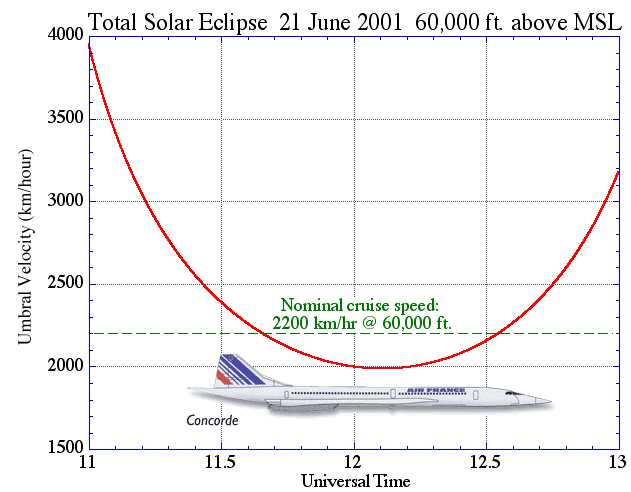
Flying at a nominal cruise speed of 2200 km/hour the Concorde can outpace the Moon's shadow as it sweeps over the Earth. By observing from the Concorde the total phase of the solar eclipse of 21 June 2001 could be observed for approximately an hour - 12 times longer than on the ground!

For a detailed tabulation of the position, velocity, and direction of the apex of the umbral shadow see Table 1.
See Table 2 for additional information on the path of the umbral shadow at 60,000 feet. Durations given therein are for a topocentrically stationary observer. The possible eclipse durations achievable by "chasing the shadow" with the Concorde are separately considered.
How well will one be able to view the 21 June 2001 eclipse from a Concorde passenger window?"
To answer this question we will have to know two things.
1) The height, width and depth of the (presumably multi-layered) window.
2) The angular position of the Sun from a line perpendicular to the surface of the window (the "window normal") during the eclipse.
Air France can provide the first piece of information,
here the second is considered. The specific details of the flight
plan for the eclipse run are still to be determined, but we define a reference
mission for the purpose of discussion which is likely to be very close
to the actual implementation. In doing so we assume a ground speed
of 2200 km/ hour giving rise to a duration of totality of approximately
one hour with a mid-eclipse intercept near the point of minimum umbral
shadow velocity. We further assume here that we will not be able
to over-fly Angolan airspace. This complicates matters a bit as we
will have to back "down track" by several minutes from the optimum point
of mid-eclipse intercept. For the purpose of discussion we therefore
adopt a "nominal" time-line with second contact at ~ 11:35 U.T. , and third
contact at 12:35 U.T.

For nearly or all of this period the Moon's topocentric umbral velocity will be slower than the cruise speed of the aircraft. We can take full advantage of this situation, maximizing the duration of totality, by flying along the track of the shadow axis. Over this time interval the altitude of the Sun is fairly highly, but changes by only a small amount, being 52.5 +/- 2.5 degrees over the entire track. The situation with respect to the horizontal position of the sun is a bit more complex. Flying this trajectory, the azimuth of the sun with respect to North declines from +19 degrees at 11:35UT to -39 degrees at 12:35UT. However, to fly this path, the heading of the aircraft must be varied over the hour of flight to follow the Moons shadow as given in Table 1. By doing this, the heading of the aircraft will change with time, and hence the orientation of the windows does not remain fixed, and the North position angle of the window normal slowly rotates during the eclipse. The combination of the change in solar azimuth due to the motion of the sun and aircraft, and the change in aircraft heading to follow the Moon's shadow will give rise to an apparent change in the "horizontal" position (with respect to the window normal) of the sun over the total phase of the eclipse from ~ +40 degrees at second contact to ~ -35 degrees at third contact.
Given the high solar elevation, and a horizontal range of motion of 75 degrees (which is for the Line-of-sight to the Sun, but does not include any paraxial (conical) margin around the Sun), the viability of observing through the Concorde passenger windows must be carefully considered and tested. It is almost a certainty that many (if not all) of the passenger seats on the sun (left) side of the aircraft will have to be removed for the flight - as is usually done for eclipse flights with passenger aircraft.
More later... In preparation.
Prepared by: Glenn Schneider
Other eclipse flights done by Glenn Schneider :